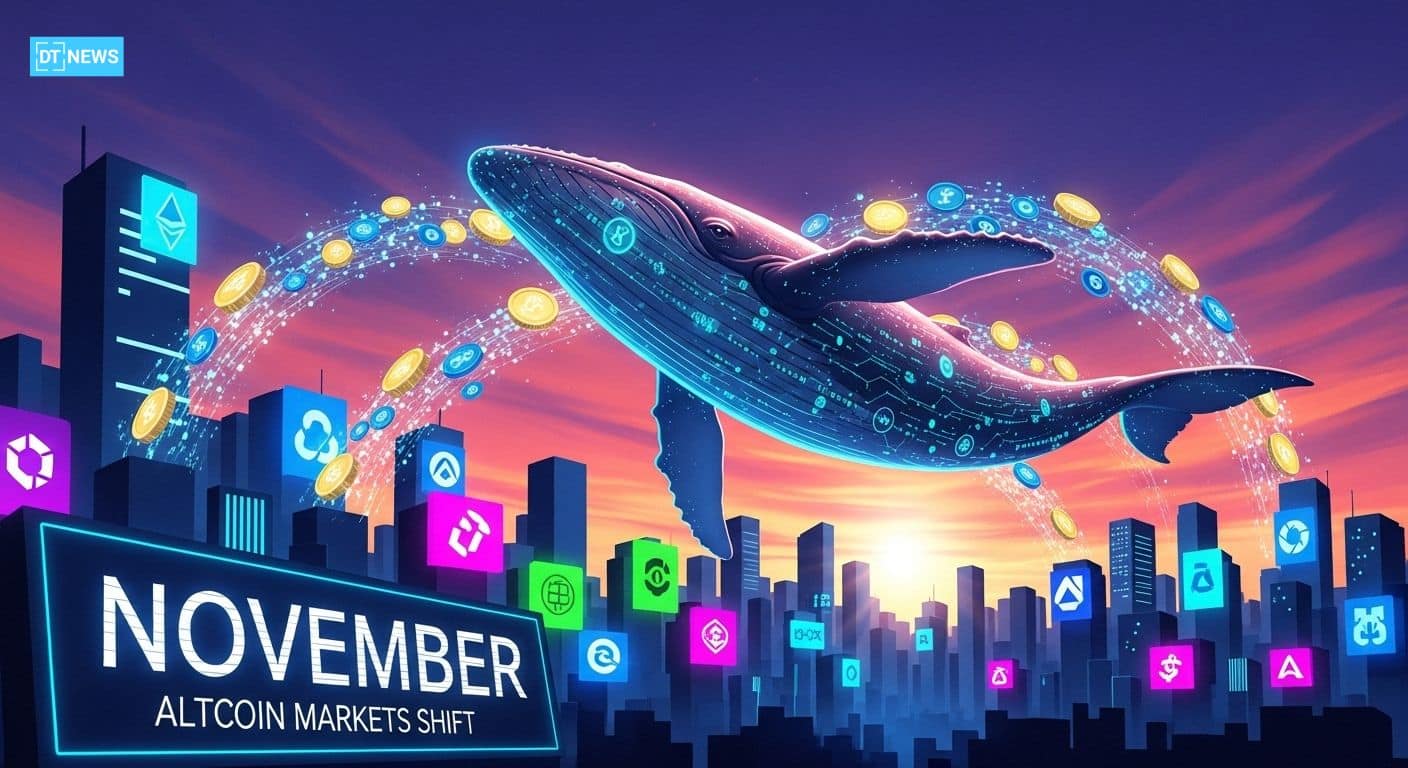This article was first published on Deythere.
- Solana (SOL): Whales Deposit to Exchanges
- Cardano (ADA): Whale Accumulation Signals
- Ripple (XRP): Escrow Unlocks and Whale Flows
- Chainlink (LINK): Steady Whale Accumulation
- Summary of Weekly Altcoin Whales Activities
- Impact of Altcoin Whales Activities the Crypto Market
- Conclusion
- Glossary
- Frequently Asked Questions About Altcoin Whales Activities This Week
Crypto whales have been busy this early November and are impacting the altcoin market. This week; whales made big moves across altcoins like Solana (SOL), Cardano (ADA), Ripple (XRP), Chainlink (LINK) and others.
Altcoins have been lagging behind Bitcoin which recently hit below $100K this week before retracing back up, however, it seems whales are positioning accordingly.
A whale moved 308,517 SOL ($57.7M) into Coinbase this week. 37.5 million ADA ($22.9M) also flowed out of Coinbase to unknown wallets. Ripple executed its monthly escrow unlock of 1 billion XRP ($2.4B), with 200M and 300M XRP to unknown wallets and 500M back into Ripple’s treasury. Chainlink whales have also been quietly accumulating millions of LINK.
Solana (SOL): Whales Deposit to Exchanges
A big Solana whale move happened earlier in the week. 308,517 SOL ($57.7M) was transferred from an unknown wallet to Coinbase. This is the first large $SOL deposit in years and likely means selling or provisioning liquidity for buyers.
In late October, a long term holder who received SOL from the project in 2020 moved 200,000 SOL ($40M) to Coinbase Prime.
These are the largest $SOL outflows since 2020 and coincided with the launch of new US spot SOL ETFs (Bitwise BSOL and Grayscale GSOL). Analysts think the timing was deliberate. With fresh ETF demand ($56M opening day inflow to BSOL), the whale supplied tokens to meet institutional orders.
Despite these massive altcoin whales activities, $SOL price stayed flat due to the market-wide selloff. On-chain data shows this whale still holds 92,824 SOL ($18M), meaning it’s not a full exit. Overall, the whale moves mean some large holders are selling into institutional demand.
It also shows Solana’s growing infrastructure is attracting capital. Big SOL deposits to exchanges can temporarily increase sell-side liquidity, but in this case, they were matched by ETF inflows.
Cardano (ADA): Whale Accumulation Signals
Cardano whales are accumulating $ADA. A $22.8M transfer (37,503,560 ADA) recently moved off Coinbase to an unknown wallet. Large holders withdrew millions of ADA from exchanges, a classic accumulation sign.
Analysts note that $ADA’s exchange netflow was negative in late October (around $3.0M), so whales and institutions might be hoarding ADA. This decline in supply on exchanges means less liquidity and more upward momentum.
Cardano’s on-chain fundamentals are strong. Network growth (wallets, transactions) is healthy and development is strong. Charts show $ADA forming a double-bottom base. Traders are watching the $0.60-$0.68 range as a possible breakout zone.
Recent whale withdrawals from Coinbase mean whales are confident in $ADA’s long term. If they keep tokens off-exchange, the reduced selling supply could help $ADA when demand returns.
Ripple (XRP): Escrow Unlocks and Whale Flows
Ripple’s monthly escrow release happened on Nov 1. 1,000,000,000 XRP ($2.4B) was unlocked in three tranches (200M, 300M, 500M). The first two tranches (200M and 300M) went to unknown wallets and the last 500M went to a known Ripple treasury account.
These are big $XRP movements; Ripple has been releasing 1B XRP per month since 2018 in 200M, 300M, 500M blocks. But these unlocks do increase the circulating supply.
The most important factor is the destination. If the $XRP goes to exchanges, it can fuel short-term selling. The unknown-wallet transfers likely ended up on exchanges or OTC desks. Though, there was some selling pressure following the unlock.
Ripple itself rotates its treasury so the inflow to its own wallet doesn’t hit the market. In essence, the escrow releases add to sell-side liquidity in the short term but are expected events. Traders should watch if these coins stay on exchanges or get re-escrowed.
Chainlink (LINK): Steady Whale Accumulation
On-chain trackers show that 100k-1M LINK holders have added around 40 million LINK over the past year. In the past month alone they bought 2.8 million LINK, including 13 million LINK during a recent dip. Santiment reports this as a 28% increase in whale holdings year-to-date.
Lookonchain flagged specific moves; one whale withdrew 62,000 LINK from OKX (up to 1.1M LINK held) and another 66,000 LINK from Kraken. These moves reduce exchange supply and show long-term confidence.
Technical analysts note $LINK is building a bullish wedge or triangle pattern and strategic news like partnerships with real-world asset projects like Balcony and S&P for risk scores; add to the bullish case.
Reports show that $LINK whales are accumulating aggressively in late 2025. This could set up for upward pressure when sentiment turns positive.
Summary of Weekly Altcoin Whales Activities
| Token | Amount | USD Value | From | To |
| SOL | 308,517 SOL | $57.7M | Unknown wallet | Coinbase |
| ADA | 37,503,560 ADA | $22.88M | Coinbase | Unknown wallet |
| XRP | 200,000,000 XRP | $481.93M | Escrow (Ripple) | Unknown wallet |
| XRP | 300,000,000 XRP | $723.52M | Escrow (Ripple) | Unknown wallet |
| XRP | 500,000,000 XRP | $1.206B | Escrow (Ripple) | Ripple treasury |
Impact of Altcoin Whales Activities the Crypto Market
Overall, this week’s altcoin whales activities are shaping November’s market. Bitcoin’s pullback below $100K before and news of upcoming altcoin ETFs creates a mixed sentiment in the altcoin market.
Now; large holders of altcoins are passing the baton; accumulating favorites and providing liquidity.
In many cases; whale accumulation where coins leave exchanges removes sell pressure and supports prices. Whales depositing to exchanges as in the case of $SOL to Coinbase or $LINK to Coinbase can mean profit-taking or at least preparing to trade.
These mixed actions create short-term volatility but show long-term confidence. Technically, $SOL and $XRP are near support zones and have strong futures open interest.
The altcoin market hasn’t yet outperformed Bitcoin but on-chain metrics suggest whales think better days are ahead. Fewer exchange balances mean less supply to sell, and ETF and partnership news is expected to keep driving demand.
If this continues, the crypto market could see momentum into late 2025. However, traders should tread with caution as whales can flip to sellers quick. For now, fresh inflows from institutional products (Solana ETFs) are offsetting near-term whale selling.
Conclusion
Altcoin whales in early November are positioning for possible market moves. Solana whales put large $SOL on exchanges with fresh ETF demand, Cardano and Chainlink whales pulled massive amounts off exchanges and built up supply. Ripple did its 1B XRP unlock which added hundreds of millions of XRP to the market (half went to Ripple itself).
These moves generally thicken the buy side and thin the sell-side liquidity on major altcoins. Short term price swings are possible but the recent pattern suggests whales are expecting an up trend in altcoins.
Overall, whales seem to be bullish for alt prices with improving macro conditions, post-rate cut liquidity, and broader crypto market rally.
Glossary
Altcoin: Any cryptocurrency other than Bitcoin. Altcoins include Solana, Cardano, and others. They often have different use cases or blockchain tech.
Crypto Whale: A holder of a large cryptocurrency balance, often in the millions. Whales can move prices by moving big amounts on or off exchanges.
Exchange Outflow/ Inflow: Outflow means coins moved from an exchange to private wallets (accumulation). Inflow means coins moved from private wallets to an exchange (selling).
On-chain Data: Data recorded on a blockchain. This includes transaction amounts, timestamps, and wallet addresses. Analysts use on-chain data to track whale moves.
Frequently Asked Questions About Altcoin Whales Activities This Week
Why are whales selling major altcoins?
Large holders often rotate funds between large-caps and smaller altcoins based on growth potential. In early November, whales were taking profits and moving capital into tokens that might outperform during the next altcoin cycle. This selective accumulation is a common move during market repositioning.
How do whale transfers affect altcoin prices?
Large transfers off exchanges to private wallets or cold storage generally mean accumulation and reduce immediate sell pressure. Whales depositing large amounts to exchanges often means selling which can push prices down in the short term. The net effect depends on the balance of these flows and market demand.
Are all altcoin whales activities bullish for the market?
Not necessarily. Whale accumulation (pulling coins off exchanges) is usually bullish as it means confidence and reduced sell supply. Whale distribution (moving coins to exchanges) can be bearish in the short term. For example; whales sending SOL to Coinbase means selling profits, SOL ETF inflows can offset that. Traders should interpret whale data along with price trends and news.
What external factors influence whale behavior?
Macroeconomic trends like U.S. interest rate policies; ETF approvals, regulatory clarity; and geopolitical tensions influence large crypto holders.
Are whales preparing for a broader altcoin rally?
Analysts suggest that the shift in whale accumulation patterns may signal early positioning for a potential late-2025 or early-2026 altcoin rally; especially as macroeconomic conditions such as rate cuts and ETF approvals affect overall liquidity.



















































































































